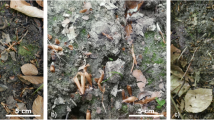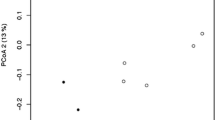Abstract
There is increasing evidence of the coexistence of trophic and environmental constraints belowground. While too often ignored in current literature, the extent to which phosphorus is relevant for soil biota was demonstrated in this study by positive correlations of soil C/P and N/P ratios with all the measured microbial parameters (biomass, density and activity), with the numerical abundance of roundworms (Nematoda) and potworms (Enchytraeidae) from lower trophic levels and with the roundworm biomass. Total worm biomass seems dependent on land use, being in rangelands about twice as high as in croplands, although the relative contribution of potworms remains comparable for both land use types (49 ± 20 % SD versus 45 ± 27 % SD). Besides soil [P], soil type plays an important role in the relative biomass of potworms compared to roundworms. Soil parameters (here pH, C/P and N/P ratios) are better predictors for the abundance and biomass of roundworms than microbial parameters. We also propose a graphical way to visualize the major responses of basal consumers to their microbial drivers.




Similar content being viewed by others
References
Andrássy I (1956) Die Rauminhalts- und Gewichtsbestimmung der Fadenwürmer (Nematoden). Acta Zool Hung 2:1–15 (in German)
Bakken LR, Olsen RA (1983) Buoyant densities and dry-matter contents of microorganisms: conversion of a measured biovolume into biomass bacteria and fungi from soil. Appl Environ Microbiol 45:1188–1195
Begon M, Townsend CR, Harper JL (2006) Ecology: from individuals to ecosystems. Blackwell, Oxford, UK
Bijlsma RJ, Lambers H (2000) A dynamic whole-plant model of integrated metabolism of nitrogen and carbon. 2. Balanced growth driven by C fluxes and regulated by signals from C and N substrate. Plant Soil 220:71–87. doi:10.1023/A:1004744903556
Bijlsma RJ, Lambers H, Kooijman SALM (2000) A dynamic whole-plant model of integrated metabolism of nitrogen and carbon. 1. Comparative ecological implications of ammonium–nitrate interactions. Plant Soil 220:49–69. doi:10.1023/A:1004779019486
Bloem J, Veninga M, Shepherd J (1995) Fully automatic determination of soil bacterium numbers, cell volumes, and frequency of dividing cells by confocal laser scanning microscopy and image analysis. Appl Environ Microbiol 61:926–936
Briones MJI, Ineson P (2002) Use of 14C carbon dating to determine feeding behaviour of enchytraeids. Soil Biol Biochem 34:881–884. doi:10.1016/S0038-0717(02)00010-X
Brussaard L, Aanen DK, Briones MJI, Decaëns T, De Deyn GB, Fayle TM, James SW, Nobre T (2012) Biogeography and phylogenetic community structure of soil invertebrate ecosystem engineers: global to local patterns, implications for ecosystem functioning and services and global environmental change impacts. In: Wall DH, Bardgett RD, Behan-Pelletier V, Herrick JE, Jones H, Ritz K, Six J, Strong DR, Van der Putten WH (eds) Soil ecology and ecosystem services. Oxford University Press, Oxford, pp 201–232
Carpenter SR, Bennett EM (2011) Reconsideration of the planetary boundary for phosphorus. Environ Res Lett 6:014009. doi:10.1088/1748-9326/6/1/014009
Coleman DC, Anderson RV, Cole CV, Elliott ET, Woods L, Campion MK (1978) Trophic interactions in soils as they affect energy and nutrient dynamics, IV. Flows of metabolic and biomass carbon. Microb Ecol 4:373–380
Cotner JB, Hall EK, Scott JT, Heldal M (2010) Freshwater bacteria are stoichiometrically flexible with a nutrient composition similar to seston. Front Microbiol 1:132. doi:10.3389/fmicb.2010.00132
Davidson EA, Howarth RW (2007) Nutrients in synergy. Nature 449:1000–1001. doi:10.1038/4491000a
Didden WAM (1993) Ecology of terrestrial Enchytraeidae. Pedobiologia 37:2–29
Didden WAM, De Fluiter R (1998) Dynamics and stratification of Enchytraeidae in the organic layer of a Scots pine forest. Biol Fertil Soils 26:305–312. doi:10.1007/s003740050381
Ellis EC, Klein Goldewijk K, Siebert S, Lightman D, Ramankutty N (2010) Anthropogenic transformation of the biomes, 1700 to 2000. Glob Ecol Biogeogr 19:589–606. doi:10.1111/j.1466-8238.2010.00540.x
Elser JJ (2011) A world awash with nitrogen. Science 334:1504–1505. doi:10.1126/science.1215567
Elser JJ, Bennett E (2011) Phosphorus cycle: a broken biogeochemical cycle. Nature 478:29–31. doi:10.1038/478029a
Elser JJ, Bracken ME, Cleland EE, Gruner DS, Harpole WS, Hillebrand H, Ngai JT, Seabloom EW, Shurin JB, Smith JE (2007) Global analysis of nitrogen and phosphorus limitation of primary producers in freshwater, marine and terrestrial ecosystems. Ecol Lett 10:1135–1142. doi:10.1111/j.1461-0248.2007.01113.x
Ferris H (2010) Form and function: metabolic footprints of nematodes in the soil food web. Eur J Soil Biol 46:97–104. doi:10.1016/j.ejsobi.2010.01.003
Gignoux J, House J, Hall D, Masse D, Nacro HB, Abbadie L (2001) Design and test of a generic cohort model of soil organic matter decomposition: the SOMKO model. Glob Ecol Biogeogr 10:639–660. doi:10.1046/j.1466-822X.2001.t01-1-00250.x
Herbert D (1976) Stoichiometric aspects of microbial growth. In: Dean ACR, Ellwood DC, Evans CGT, Melling J (eds) Continuous culture 6: application and new fields. Ellis Horwood, Chichester, pp 1–30
Hunt HW, Wall DH (2002) Modeling the effects of loss of soil biodiversity on ecosystem function. Glob Chang Biol 8:32–49. doi:10.1046/j.1365-2486.2002.00425.x
Hunt HW, Coleman DC, Ingham ER, Ingham RE, Elliott ET, Moore JC, Rose SL, Reid CPP, Morley CR (1987) The detrital food web in a shortgrass prairie. Biol Fertil Soils 3:57–68. doi:10.1007/BF00260580
Jänsch S, Römbke J, Didden W (2005) The use of enchytraeids in ecological soil classification and assessment concepts. Ecotoxicol Environ Saf 62:266–277. doi:10.1016/j.ecoenv.2004.10.025
Kaspari M (2004) Using the metabolic theory of ecology to predict global patterns of abundance. Ecology 85:1800–1802. doi:10.1890/03-0682
Kaspari M, Weiser MD (2012) Energy, taxonomic aggregation, and the geography of ant abundance. Ecography 35:65–72. doi:10.1111/j.1600-0587.2011.06971.x
Keiblinger KM, Hall EK, Wanek W, Szukics U, Hämmerle I, Ellersdorfer G, Böck S, Strauss J, Sterflinger K, Richter A, Zechmeister-Boltenstern S (2010) The effect of resource quantity and resource stoichiometry on microbial carbon-use-efficiency. FEMS Microbiol Ecol 73:430–440. doi:10.1111/j.1574-6941.2010.00912.x
Lavorel S, Storkey J, Bardgett RD, De Bello F, Berg MP, Le Roux X, Moretti M, Mulder C, Pakeman RJ, Díaz S, Harrington R (2013) A novel framework for linking functional diversity of plants and other trophic levels for the quantification of ecosystem services. J Veg Sci doi: 10.1111/jvs.12083
MacDonald GK, Bennett EM, Potter PA, Ramankutty N (2011) Agronomic phosphorus imbalances across the world's croplands. Proc Natl Acad Sci U S A 108:3086–3091. doi:10.1073/pnas.1010808108
Martin LJ, Blossey B, Ellis E (2012) Mapping where ecologists work: biases in the global distribution of terrestrial ecological observations. Front Ecol Environ 10:195–201. doi:10.1890/110154
Moore JC, Hunt HW (1988) Resource compartmentation and the stability of real ecosystems. Nature 333:261–263. doi:10.1038/333261a0
Moore JC, McCann K, Setälä H, De Ruiter PC (2003) Top-down is bottom-up: does predation in the rhizosphere regulate aboveground dynamics? Ecology 84:846–857. doi:10.1890/0012-9658(2003)084[0846:TIBDPI]2.0.CO;2
Mulder C, Elser JJ (2009) Soil acidity, ecological stoichiometry and allometric scaling in grassland food webs. Glob Chang Biol 15:2730–2738. doi:10.1111/j.1365-2486.2009.01899.x
Mulder C, Vonk JA (2011) Nematode traits and environmental constraints in 200 soil systems: scaling within the 60–6,000 μm body size range. Ecology 92:2004. doi:10.1890/11-0546.1
Mulder C, Cohen JE, Setälä H, Bloem J, Breure AM (2005) Bacterial traits, organism mass, and numerical abundance in the detrital soil food web of Dutch agricultural grasslands. Ecol Lett 8:80–90. doi:10.1111/j.1461-0248.2004.00704.x
Mulder C, Den Hollander HA, Vonk JA, Rossberg AG, Jagers op Akkerhuis GAJM, Yeates GW (2009) Soil resource supply influences faunal size-specific distributions in natural food webs. Naturwissenschaften 96:813–826. doi:10.1007/s00114-009-0539-4
Mulder C, Boit A, Bonkowski M, De Ruiter PC, Mancinelli G, Van der Heijden MGA, Van Wijnen HJ, Vonk JA, Rutgers M (2011) A belowground perspective on Dutch agroecosystems: how soil organisms interact to support ecosystem services. Adv Ecol Res 44:277–357. doi:10.1016/B978-0-12-374794-5.00005-5
Mulder C, Boit A, Mori S, Vonk JA, Dyer SD, Faggiano L, Geisen S, González AL, Kaspari M, Lavorel S, Marquet PA, Rossberg AG, Sterner RW, Voigt W, Wall DH (2012) Distributional (in)congruence of biodiversity–ecosystem functioning. Adv Ecol Res 46:1–88. doi:10.1016/B978-0-12-396992-7.00001-0
Neher DA, Campbell CL (1994) Nematode communities and microbial biomass in soils with annual and perennial crops. Appl Soil Ecol 1:17–28. doi:10.1016/0929-1393(94)90020-5
Oberholzer HR, Höper H (2000) Reference systems for the microbiological evaluation of soils. Verband Deutscher Landwirtschaftlicher Untersuchungs- und Forschungsanstalten 55:19–34
Oostenbrink M (1960) Estimate nematode populations by some selected methods. In: Sasser JN, Jenkins WR (eds) Nematology. University of North Carolina Press, Chapel Hill, NC, pp 85–102
Peñuelas J, Sardans J, Rivas-Ubach A, Janssens IA (2012) The human-induced imbalance between C, N and P in Earth's life system. Glob Chang Biol 18:3–6. doi:10.1111/j.1365-2486.2011.02568.x
Petersen H, Luxton M (1982) A comparative analysis of soil fauna populations and their role in decomposition processes. Oikos 39:288–388
Postma-Blaauw MB, De Goede RGM, Bloem J, Faber JH, Brussaard L (2012) Agricultural intensification and de-intensification differentially affect taxonomic diversity of predatory mites, earthworms, enchytraeids, nematodes and bacteria. Appl Soil Ecol 57:39–49. doi:10.1016/j.apsoil.2012.02.011
Rousk J, Brookes PC, Bååth E (2009) Contrasting soil pH effects on fungal and bacterial growth suggest functional redundancy in carbon mineralization. Appl Environ Microbiol 75:1589–1596. doi:10.1128/AEM.02775-08
Rutgers M, Schouten AJ, Bloem J, Van Eekeren N, De Goede RGM, Jagers op Akkerhuis GAJM, Van der Wal A, Mulder C, Brussaard L, Breure AM (2009) Biological measurements in a nationwide soil monitoring network. Eur J Soil Sci 60:820–832. doi:10.1111/j.1365-2389.2009.01163.x
Scheunemann N, Scheu S, Butenschoen O (2010) Incorporation of decade old soil carbon into the soil animal food web of an arable system. Appl Soil Ecol 46:59–63. doi:10.1016/j.apsoil.2010.06.014
Statzner B, Hildrew AG, Resh VH (2001) Species traits and environmental constraints: entomological research and the history of ecological theory. Annu Rev Entomol 46:291–316. doi:10.1146/annurev.ento.46.1.291
Van Vliet PCJ, Beare MH, Coleman DC (1995) Population dynamics and functional roles of Enchytraeidae (Oligochaeta) in hardwood forest and agricultural ecosystems. Plant Soil 170:199–207. doi:10.1007/BF02183067
Vitousek PM, Naylor R, Crews T, David MB, Drinkwater LE, Holland E, Johnes PJ, Katzenberger J, Martinelli LA, Matson PA, Nziguheba G, Ojima D, Palm CA, Robertson GP, Sanchez PA, Townsend AR, Zhang FS (2009) Nutrient imbalances in agricultural development. Science 324:1519–1520. doi:10.1126/science.1170261
Wardle DA (1993) Changes in the microbial biomass and metabolic quotient during leaf litter succession in some New Zealand forest and scrubland ecosystems. Funct Ecol 7:346–355
Wardle DA, Barker GM (1997) Competition and herbivory in establishing grassland communities: implications for plant biomass, species diversity and soil microbial activity. Oikos 80:470–480
Wardle DA, Barker GM, Bonner KI, Nicholson KS (1998) Can comparative approaches based on plant ecophysiological traits predict the nature of biotic interactions and individual plant species effects in ecosystems? J Ecol 86:405–420. doi:10.1046/j.1365-2745.1998.00268.x
Wardle DA, Bardgett RD, Klironomos JN, Setälä H, Van der Putten WH, Wall DH (2004) Ecological linkages between aboveground and belowground biota. Science 304:1629–1633. doi:10.1126/science.1094875
Wolters V (2000) Invertebrate control of soil organic matter stability. Biol Fertil Soils 31:1–19. doi:10.1007/s003740050618
Yeates GW, Bongers T, De Goede RGM, Freckmann DW, Georgieva SS (1993) Feeding habits in nematode families and genera—an outline for soil ecologists. J Nematol 25:315–331
Acknowledgments
We wish to thank Jaap Bloem for microbial analyses, Harm Keidel and Tamás Salánki for faunal analyses, Anton Schouten and Jaap Bogte for data mining, and Ron de Goede, Hans Helder, Valentina Sechi, Harm van Wijnen and four anonymous referees for their helpful comments. Our research was financially supported by ERGO grants 838.06.063 and 838.06.064 of The Netherlands Organization for Scientific Research and partly by the ESF Research Network Programme for “Body Size and Ecosystem Dynamics”.
Author information
Authors and Affiliations
Corresponding author
Additional information
Communicated by: Sven Thatje
Electronic supplementary material
Below is the link to the electronic supplementary material.
ESM 1
(DOC 71 kb)
Rights and permissions
About this article
Cite this article
Vonk, J.A., Mulder, C. Contrasting influence of soil nutrients and microbial community on differently sized basal consumers. Naturwissenschaften 100, 611–620 (2013). https://doi.org/10.1007/s00114-013-1058-x
Received:
Revised:
Accepted:
Published:
Issue Date:
DOI: https://doi.org/10.1007/s00114-013-1058-x




